בדומה לגרסאות קודמות, Android 15 כולל שינויים בהתנהגות שעשויים להשפיע על האפליקציה שלכם. שינויי ההתנהגות הבאים רלוונטיים רק לאפליקציות שמטרגטות את Android 15 ואילך. אם האפליקציה שלכם מטרגטת את Android מגרסה 15 ואילך, אתם צריכים לשנות את האפליקציה כדי שהיא תתמוך בהתנהגויות האלה, במקרים הרלוונטיים.
חשוב גם לבדוק את רשימת השינויים בהתנהגות שמשפיעים על כל האפליקציות שפועלות ב-Android 15, בלי קשר ל-targetSdkVersion של האפליקציה.
פונקציונליות עיקרית
Android 15 משנה או מרחיב יכולות ליבה שונות של מערכת Android.
שינויים בשירותים שפועלים בחזית
אנחנו מבצעים את השינויים הבאים בשירותים שפועלים בחזית ב-Android 15.
- התנהגות של זמן קצוב לתפוגה בשירות 'סנכרון נתונים' שפועל בחזית
- סוג חדש של שירות שפועל בחזית לעיבוד מדיה
- הגבלות על מקלטי שידורים מסוג
BOOT_COMPLETEDשמפעילים שירותים שפועלים בחזית - הגבלות על הפעלת שירותים שפועלים בחזית בזמן שאפליקציה מחזיקה בהרשאה
SYSTEM_ALERT_WINDOW
התנהגות זמן קצוב לתפוגה של שירות בחזית לסנכרון נתונים
ב-Android 15 נוספה התנהגות חדשה של זמן קצוב לתפוגה ל-dataSync באפליקציות שמטרגטות ל-Android 15 (רמת API 35) ואילך. ההתנהגות הזו רלוונטית גם לסוג החדש של שירות mediaProcessing שפועל בחזית.
המערכת מאפשרת לשירותי dataSync של אפליקציה לפעול במשך 6 שעות בסך הכול בתקופה של 24 שעות, ולאחר מכן המערכת קוראת ל-method Service.onTimeout(int, int) של השירות שפועל (התכונה הזו נוספה ב-Android 15). בשלב הזה, לשירות יש כמה שניות לבצע קריאה ל-Service.stopSelf(). כשקוראים לפונקציה Service.onTimeout(), השירות כבר לא נחשב לשירות שפועל בחזית. אם השירות לא קורא ל-Service.stopSelf(), המערכת תיצור חריגה פנימית. החריגה מתועדת ב-Logcat עם ההודעה הבאה:
Fatal Exception: android.app.RemoteServiceException: "A foreground service of
type dataSync did not stop within its timeout: [component name]"
כדי למנוע בעיות שקשורות לשינוי הזה בהתנהגות, אפשר לבצע אחת או יותר מהפעולות הבאות:
- מטמיעים את השיטה החדשה
Service.onTimeout(int, int)בשירות. כשהאפליקציה תקבל את הקריאה החוזרת, חשוב להתקשר למספרstopSelf()תוך כמה שניות. (אם לא עוצרים את האפליקציה מיד, המערכת יוצרת כשל). - חשוב לוודא ששירותי
dataSyncשל האפליקציה לא פועלים במשך יותר מ-6 שעות בסך הכול בכל תקופה של 24 שעות (אלא אם המשתמש יוצר אינטראקציה עם האפליקציה, ומאפס את הטיימר). - הפעלת שירותים שפועלים בחזית
dataSyncרק כתוצאה מאינטראקציה ישירה של המשתמש. מכיוון שהאפליקציה פועלת בחזית כשהשירות מופעל, השירות פועל במשך 6 שעות בלבד אחרי שהאפליקציה עוברת לרקע. - במקום להשתמש בשירות
dataSyncשפועל בחזית, צריך להשתמש בAPI חלופי.
אם השירותים שפועלים בחזית ב-dataSync באפליקציה פועלים במשך 6 שעות ב-24 השעות האחרונות, לא ניתן להפעיל שירות נוסף שפועל בחזית של dataSync אלא אם המשתמש העביר את האפליקציה לחזית האפליקציה (הפעולה הזו מאפסת את הטיימר). אם תנסו להפעיל שירות אחר שפועל בחזית של dataSync, המערכת תגרור ForegroundServiceStartNotAllowedException הודעת שגיאה כמו "Time limit limit for data Sync type" (סוג שירות שפועל בחזית).
בדיקה
כדי לבדוק את התנהגות האפליקציה, אפשר להפעיל זמן קצוב לסיום הסנכרון של הנתונים גם אם האפליקציה לא מטרגטת ל-Android 15 (כל עוד האפליקציה פועלת במכשיר עם Android 15). כדי להפעיל זמן קצוב לתפוגה, מריצים את הפקודה הבאה ב-adb:
adb shell am compat enable FGS_INTRODUCE_TIME_LIMITS your-package-name
אפשר גם לשנות את משך הזמן של הזמן הקצוב לתפוגה, כדי שיהיה קל יותר לבדוק איך האפליקציה מתנהגת כשמגיעים למגבלה. כדי להגדיר פרק זמן חדש לזמן קצוב, מריצים את הפקודה adb הבאה:
adb shell device_config put activity_manager data_sync_fgs_timeout_duration duration-in-milliseconds
סוג חדש של שירות שפועל בחזית לעיבוד מדיה
ב-Android 15 מוצג סוג חדש של שירות שפועל בחזית, mediaProcessing. סוג השירות הזה מתאים לפעולות כמו המרת קידוד של קובצי מדיה. לדוגמה, אפליקציית מדיה עשויה להוריד קובץ אודיו ולהמיר אותו לפורמט אחר לפני ההפעלה. אתם יכולים להשתמש בשירות mediaProcessing שפועל בחזית כדי לוודא שההמרה תימשך גם כשהאפליקציה ברקע.
המערכת מאפשרת לשירותי mediaProcessing של אפליקציה לפעול במשך 6 שעות בסך הכול בתקופה של 24 שעות, ולאחר מכן המערכת קוראת ל-method Service.onTimeout(int, int) של השירות שפועל (הmethod הזה הוצג ב-Android 15). בשלב הזה, לשירות יש כמה שניות לבצע קריאה ל-Service.stopSelf(). אם השירות לא קורא ל-Service.stopSelf(), המערכת גורמת לחריגה פנימית. החריג מתועד ביומן Logcat עם ההודעה הבאה:
Fatal Exception: android.app.RemoteServiceException: "A foreground service of
type mediaProcessing did not stop within its timeout: [component name]"
כדי למנוע את החריגה, אפשר לבצע אחת מהפעולות הבאות:
- עליך להטמיע בשירות שלך את השיטה החדשה של
Service.onTimeout(int, int). כשהאפליקציה מקבלת את הקריאה החוזרת, חשוב להקפיד להתקשר ל-stopSelf()תוך מספר שניות. (אם לא מפסיקים את האפליקציה מיד, המערכת יוצרת כשל). - חשוב לוודא ששירותי
mediaProcessingשל האפליקציה לא פועלים במשך יותר מ-6 שעות בסך הכול בכל תקופה של 24 שעות (אלא אם המשתמש יוצר אינטראקציה עם האפליקציה, ומאפס את הטיימר). - כדאי להפעיל שירותים
mediaProcessingשפועלים בחזית רק כתוצאה מאינטראקציה ישירה של משתמש. מכיוון שהאפליקציה נמצאת בחזית כשהשירות מופעל, השירות מקבל את שש השעות המלאות אחרי שהאפליקציה עוברת לרקע. - במקום להשתמש בשירות שפועל בחזית
mediaProcessing, צריך להשתמש בAPI חלופי, כמו WorkManager.
אם שירותי mediaProcessing של האפליקציה פעלו בחזית במשך 6 שעות ב-24 השעות האחרונות, לא תוכלו להפעיל שירות mediaProcessing נוסף בחזית אלא אם המשתמש העביר את האפליקציה לחזית (פעולה שמאפסת את הטיימר). אם תנסו להפעיל שירות mediaProcessing שפועל בחזית, המערכת תשליך את הערך ForegroundServiceStartNotAllowedException עם הודעת שגיאה כמו "Time Limit כבר נשלחת לכל שירות שפועל בחזית מסוג mediaProcessing".
מידע נוסף על סוג השירות mediaProcessing זמין במאמר שינויים בסוגי שירותים בחזית במהדורת Android 15: עיבוד מדיה.
בדיקה
כדי לבדוק את התנהגות האפליקציה, אפשר להפעיל זמן קצוב לתפוגה של עיבוד מדיה גם אם האפליקציה לא מטרגטת ל-Android 15 (כל עוד האפליקציה פועלת במכשיר עם Android 15). כדי להפעיל זמן קצוב לתפוגה, מריצים את הפקודה הבאה ב-adb:
adb shell am compat enable FGS_INTRODUCE_TIME_LIMITS your-package-name
אפשר גם לשנות את משך הזמן של הזמן הקצוב לתפוגה, כדי שיהיה קל יותר לבדוק איך האפליקציה מתנהגת כשמגיעים למגבלה. כדי להגדיר פרק זמן חדש לתפוגה, מריצים את הפקודה הבאה של adb:
adb shell device_config put activity_manager media_processing_fgs_timeout_duration duration-in-milliseconds
הגבלות על מקלטי שידורים מסוג BOOT_COMPLETED שמפעילים שירותים שפועלים בחזית
יש הגבלות חדשות על השקת מקלטי שידור של BOOT_COMPLETED
שירותים שפועלים בחזית. למקלטי BOOT_COMPLETED אסור להפעיל את
הסוגים הבאים של שירותים שפועלים בחזית:
dataSynccameramediaPlaybackphoneCallmediaProjectionmicrophone(ההגבלה הזו חלה עלmicrophoneמאז Android 14)
אם מקלט BOOT_COMPLETED מנסה להפעיל אחד מהסוגים האלה של חזית
השירותים האלה, המערכת מטילה ForegroundServiceStartNotAllowedException.
בדיקה
כדי לבדוק את התנהגות האפליקציה, אפשר להפעיל את ההגבלות החדשות האלה גם אם
האפליקציה לא מטרגטת ל-Android 15 (כל עוד האפליקציה פועלת עם Android 15).
במכשיר). מריצים את הפקודה adb הבאה:
adb shell am compat enable FGS_BOOT_COMPLETED_RESTRICTIONS your-package-name
כדי לשלוח שידור של BOOT_COMPLETED בלי להפעיל מחדש את המכשיר:
מריצים את הפקודה הבאה של adb:
adb shell am broadcast -a android.intent.action.BOOT_COMPLETED your-package-name
הגבלות על הפעלת שירותים שפועלים בחזית בזמן שאפליקציה מחזיקה בהרשאה SYSTEM_ALERT_WINDOW
Previously, if an app held the SYSTEM_ALERT_WINDOW permission, it could launch
a foreground service even if the app was currently in the background (as
discussed in exemptions from background start restrictions).
If an app targets Android 15, this exemption is now narrower. The app now needs
to have the SYSTEM_ALERT_WINDOW permission and also have a visible overlay
window. That is, the app needs to first launch a
TYPE_APPLICATION_OVERLAY window and the window
needs to be visible before you start a foreground service.
If your app attempts to start a foreground service from the background without
meeting these new requirements (and it does not have some other exemption), the
system throws ForegroundServiceStartNotAllowedException.
If your app declares the SYSTEM_ALERT_WINDOW permission
and launches foreground services from the background, it may be affected by this
change. If your app gets a ForegroundServiceStartNotAllowedException, check
your app's order of operations and make sure your app already has an active
overlay window before it attempts to start a foreground service from the
background. You can check if your overlay window is currently visible
by calling View.getWindowVisibility(), or you
can override View.onWindowVisibilityChanged()
to get notified whenever the visibility changes.
Testing
To test your app's behavior, you can enable these new restrictions even if your
app is not targeting Android 15 (as long as the app is running on an Android 15
device). To enable these new restrictions on starting foreground services
from the background, run the following adb command:
adb shell am compat enable FGS_SAW_RESTRICTIONS your-package-name
שינויים במועד שבו אפליקציות יכולות לשנות את המצב הגלובלי של המצב 'נא לא להפריע'
Apps that target Android 15 (API level 35) and higher can no longer change the
global state or policy of Do Not Disturb (DND) on a device (either by modifying
user settings, or turning off DND mode). Instead, apps must contribute an
AutomaticZenRule, which the system combines into a global policy with the
existing most-restrictive-policy-wins scheme. Calls to existing APIs that
previously affected global state (setInterruptionFilter,
setNotificationPolicy) result in the creation or update of an implicit
AutomaticZenRule, which is toggled on and off depending on the call-cycle of
those API calls.
Note that this change only affects observable behavior if the app is calling
setInterruptionFilter(INTERRUPTION_FILTER_ALL) and expects that call to
deactivate an AutomaticZenRule that was previously activated by their owners.
שינויים ב-OpenJDK API
ב-Android 15 אנחנו ממשיכים את העבודה על רענון ספריות הליבה של Android כדי להתאים אותן לתכונות בגרסאות ה-LTS האחרונות של OpenJDK.
חלק מהשינויים האלה יכולים להשפיע על תאימות האפליקציה לאפליקציות שמטרגטות ל-Android 15 (רמת API 35):
שינויים בממשקי API לעיצוב מחרוזות: האימות של אינדקס הארגומנט, הדגלים, הרוחב והדיוק מחמיר יותר עכשיו כשמשתמשים בממשקי ה-API הבאים:
String.format()ו-Formatter.format():String.format(String, Object[])String.format(Locale, String, Object[])Formatter.format(String, Object[])Formatter.format(Locale, String, Object[])
לדוגמה, החריגה הבאה מופעלת כשמשתמשים באינדקס ארגומנט של 0 (
%0במחרוזת הפורמט):IllegalFormatArgumentIndexException: Illegal format argument index = 0במקרה כזה, אפשר לפתור את הבעיה באמצעות אינדקס ארגומנט של 1 (
%1במחרוזת הפורמט).שינויים בסוג הרכיב של
Arrays.asList(...).toArray(): כשמשתמשים ב-Arrays.asList(...).toArray(), סוג הרכיב של המערך שמתקבל הוא עכשיוObject– ולא הסוג של הרכיבים במערך הבסיסי. לכן הקוד הבא יחזירClassCastException:String[] elements = (String[]) Arrays.asList("one", "two").toArray();במקרה כזה, כדי לשמור את
Stringכסוג הרכיב במערך שמתקבל, אפשר להשתמש ב-Collection.toArray(Object[])במקום:String[] elements = Arrays.asList("two", "one").toArray(new String[0]);שינויים בטיפול בקודי שפה: כשמשתמשים ב-API
Locale, קודי השפה לעברית, יידיש ואינדונזית לא מומרים יותר לפורמטים שיצאו משימוש (עברית:iw, יידיש:jiואינדונזית:in). כשמציינים את קוד השפה לאחד מהלוקאלים האלה, צריך להשתמש בקודים לפי תקן ISO 639-1 (עברית:he, יידיש:yiואינדונזית:id).שינויים ברצפים של מספרים שלמים אקראיים: בעקבות השינויים שבוצעו בכתובת https://bugs.openjdk.org/browse/JDK-8301574, השיטות הבאות של
Random.ints()מחזירות עכשיו רצף שונה של מספרים בהשוואה לשיטות שלRandom.nextInt():בדרך כלל, השינוי הזה לא אמור לגרום להתנהגות שמשבשת את האפליקציה, אבל הקוד לא אמור לצפות שהרצף שנוצר משיטות
Random.ints()יתאים ל-Random.nextInt().
ה-API החדש SequencedCollection יכול להשפיע על התאימות של האפליקציה אחרי עדכון compileSdk בהגדרות הבנייה של האפליקציה לשימוש ב-Android 15 (רמת API 35):
התנגשות עם פונקציות של התוספים
MutableList.removeFirst()ו-MutableList.removeLast()ב-kotlin-stdlibהסוג
Listב-Java ממופה לסוגMutableListב-Kotlin. ממשקי ה-APIList.removeFirst()ו-List.removeLast()נוספו ב-Android 15 (רמת API 35), לכן קומפיילר Kotlin פותר קריאות לפונקציות, למשלlist.removeFirst(), באופן סטטי לממשקי ה-API החדשיםListבמקום לפונקציות ההרחבה ב-kotlin-stdlib.אם קומפלו מחדש אפליקציה עם
compileSdkשהוגדר ל-35ו-minSdkשהוגדר ל-34או לגרסה מוקדמת יותר, ואז האפליקציה מופעלת ב-Android 14 ובגרסאות קודמות, מוצגת שגיאת זמן ריצה:java.lang.NoSuchMethodError: No virtual method removeFirst()Ljava/lang/Object; in class Ljava/util/ArrayList;אפשר להשתמש באפשרות
NewApilint הקיימת בפלאגין Android Gradle כדי לזהות שימושים חדשים ב-API../gradlew lintMainActivity.kt:41: Error: Call requires API level 35 (current min is 34): java.util.List#removeFirst [NewApi] list.removeFirst()כדי לתקן את חריגת זמן הריצה ואת שגיאות ה-lint, אפשר להחליף את הקריאות לפונקציות
removeFirst()ו-removeLast()ב-Kotlin בפונקציותremoveAt(0)ו-removeAt(list.lastIndex)בהתאמה. אם אתם משתמשים ב-Android Studio Ladybug | 2024.1.3 ואילך, יש גם אפשרות לתיקון מהיר של השגיאות האלה.אם האפשרות lint מושבתת, כדאי להסיר את התווים
@SuppressLint("NewApi")ו-lintOptions { disable 'NewApi' }.התנגשות עם שיטות אחרות ב-Java
נוספו שיטות חדשות לסוגים הקיימים, לדוגמה,
Listו-Deque. יכול להיות שהשיטות החדשות האלה לא יהיו תואמות לשיטות עם אותו שם וסוגי ארגומנטים בממשקים ובמחלקות אחרים. במקרה של התנגשות בחתימת שיטה עם חוסר תאימות, מהדרjavacמוציא שגיאה בזמן הבנייה. לדוגמה:דוגמה לשגיאה 1:
javac MyList.javaMyList.java:135: error: removeLast() in MyList cannot implement removeLast() in List public void removeLast() { ^ return type void is not compatible with Object where E is a type-variable: E extends Object declared in interface Listשגיאה לדוגמה 2:
javac MyList.javaMyList.java:7: error: types Deque<Object> and List<Object> are incompatible; public class MyList implements List<Object>, Deque<Object> { both define reversed(), but with unrelated return types 1 errorשגיאה לדוגמה 3:
javac MyList.javaMyList.java:43: error: types List<E#1> and MyInterface<E#2> are incompatible; public static class MyList implements List<Object>, MyInterface<Object> { class MyList inherits unrelated defaults for getFirst() from types List and MyInterface where E#1,E#2 are type-variables: E#1 extends Object declared in interface List E#2 extends Object declared in interface MyInterface 1 errorכדי לתקן את שגיאות ה-build האלה, המחלקה שמטמיעה את הממשקים האלה צריכה לבטל את השיטה עם סוג החזרה תואם. לדוגמה:
@Override public Object getFirst() { return List.super.getFirst(); }
אבטחה
Android 15 כולל שינויים שמקדמים את אבטחת המערכת כדי לעזור להגן על אפליקציות ומשתמשים מפני אפליקציות זדוניות.
גרסאות TLS מוגבלות
ב-Android 15 יש הגבלה על השימוש ב-TLS בגרסאות 1.0 ו-1.1. הגרסאות האלה הוצאו משימוש ב-Android, אבל עכשיו אסור להשתמש בהן באפליקציות שמטרגטות את Android 15.
הפעלות מאובטחות של פעילות ברקע
Android 15 protects users from malicious apps and gives them more control over their devices by adding changes that prevent malicious background apps from bringing other apps to the foreground, elevating their privileges, and abusing user interaction. Background activity launches have been restricted since Android 10 (API level 29).
Other changes
In addition to the restriction for UID matching, these other changes are also included:
- Change
PendingIntentcreators to block background activity launches by default. This helps prevent apps from accidentally creating aPendingIntentthat could be abused by malicious actors. - Don't bring an app to the foreground unless the
PendingIntentsender allows it. This change aims to prevent malicious apps from abusing the ability to start activities in the background. By default, apps are not allowed to bring the task stack to the foreground unless the creator allows background activity launch privileges or the sender has background activity launch privileges. - Control how the top activity of a task stack can finish its task. If the top activity finishes a task, Android will go back to whichever task was last active. Moreover, if a non-top activity finishes its task, Android will go back to the home screen; it won't block the finish of this non-top activity.
- Prevent launching arbitrary activities from other apps into your own task. This change prevents malicious apps from phishing users by creating activities that appear to be from other apps.
- Block non-visible windows from being considered for background activity launches. This helps prevent malicious apps from abusing background activity launches to display unwanted or malicious content to users.
כוונות רכישה בטוחות יותר
Android 15 introduces new optional security measures to make intents safer and more robust. These changes are aimed at preventing potential vulnerabilities and misuse of intents that can be exploited by malicious apps. There are two main improvements to the security of intents in Android 15:
- Match target intent-filters: Intents that target specific components must accurately match the target's intent-filter specifications. If you send an intent to launch another app's activity, the target intent component needs to align with the receiving activity's declared intent-filters.
- Intents must have actions: Intents without an action will no longer match any intent-filters. This means that intents used to start activities or services must have a clearly defined action.
In order to check how your app responds to these changes, use
StrictMode in your app. To see detailed
logs about Intent usage violations, add the following method:
Kotlin
fun onCreate() { StrictMode.setVmPolicy(VmPolicy.Builder() .detectUnsafeIntentLaunch() .build() ) }
Java
public void onCreate() { StrictMode.setVmPolicy(new VmPolicy.Builder() .detectUnsafeIntentLaunch() .build()); }
חוויית המשתמש וממשק המשתמש של המערכת
Android 15 כוללת כמה שינויים שנועדו ליצור חוויית משתמש עקבית ואינטואיטיבית יותר.
שינויים בהזחה של חלון
There are two changes related to window insets in Android 15: edge-to-edge is enforced by default, and there are also configuration changes, such as the default configuration of system bars.
אכיפה מקצה לקצה
Apps are edge-to-edge by default on devices running Android 15 if the app is targeting Android 15 (API level 35).
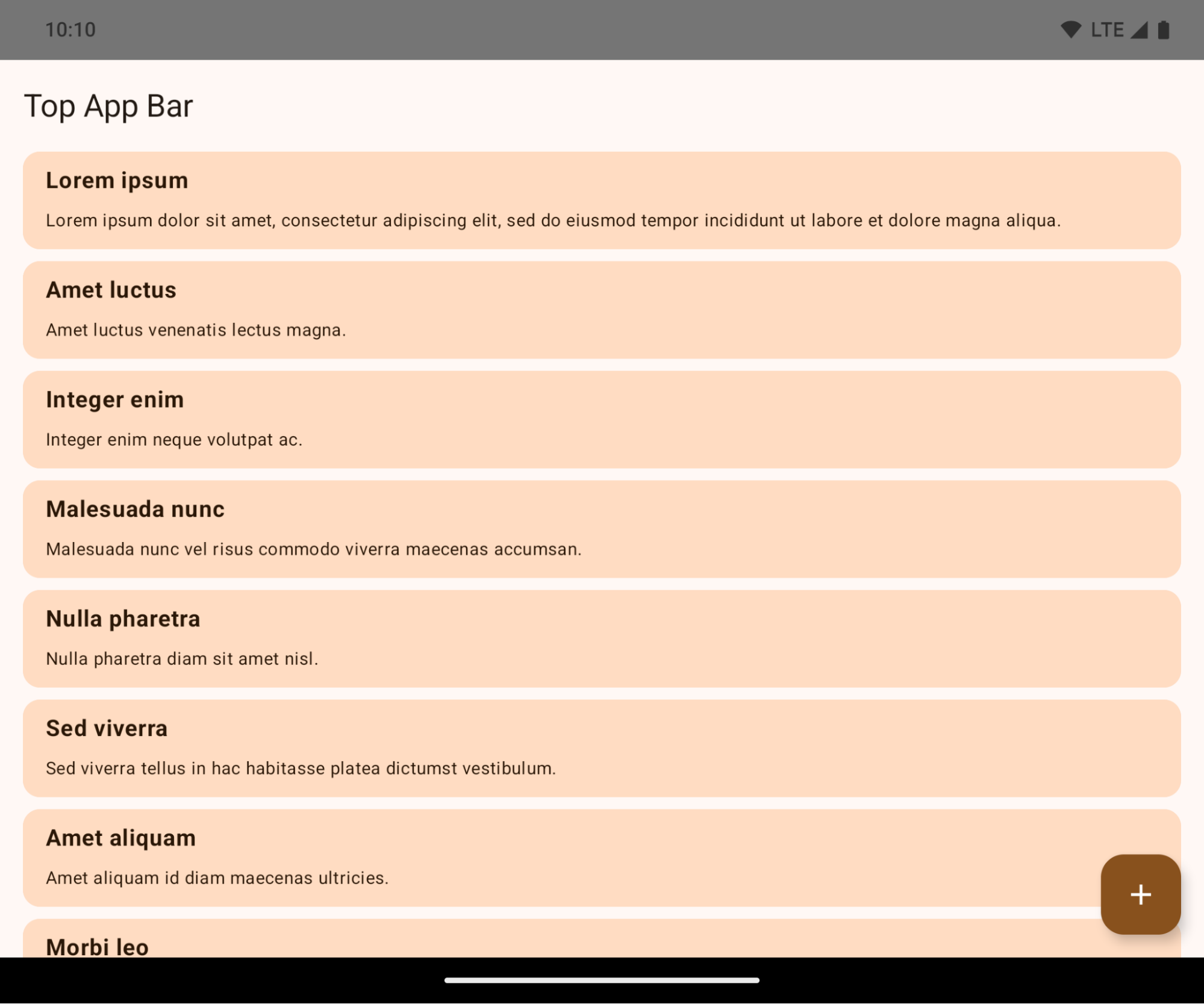
This is a breaking change that might negatively impact your app's UI. The changes affect the following UI areas:
- Gesture handle navigation bar
- Transparent by default.
- Bottom offset is disabled so content draws behind the system navigation bar unless insets are applied.
setNavigationBarColorandR.attr#navigationBarColorare deprecated and don't affect gesture navigation.setNavigationBarContrastEnforcedandR.attr#navigationBarContrastEnforcedcontinue to have no effect on gesture navigation.
- 3-button navigation
- Opacity set to 80% by default, with color possibly matching the window background.
- Bottom offset disabled so content draws behind the system navigation bar unless insets are applied.
setNavigationBarColorandR.attr#navigationBarColorare set to match the window background by default. The window background must be a color drawable for this default to apply. This API is deprecated but continues to affect 3-button navigation.setNavigationBarContrastEnforcedandR.attr#navigationBarContrastEnforcedis true by default, which adds an 80% opaque background across 3-button navigation.
- Status bar
- Transparent by default.
- The top offset is disabled so content draws behind the status bar unless insets are applied.
setStatusBarColorandR.attr#statusBarColorare deprecated and have no effect on Android 15.setStatusBarContrastEnforcedandR.attr#statusBarContrastEnforcedare deprecated but still have an effect on Android 15.
- Display cutout
layoutInDisplayCutoutModeof non-floating windows must beLAYOUT_IN_DISPLAY_CUTOUT_MODE_ALWAYS.SHORT_EDGES,NEVER, andDEFAULTare interpreted asALWAYSso that users don't see a black bar caused by the display cutout and appear edge-to-edge.
The following example shows an app before and after targeting Android 15 (API level 35), and before and after applying insets. This example is not comprehensive, this might appear differently on Android Auto.
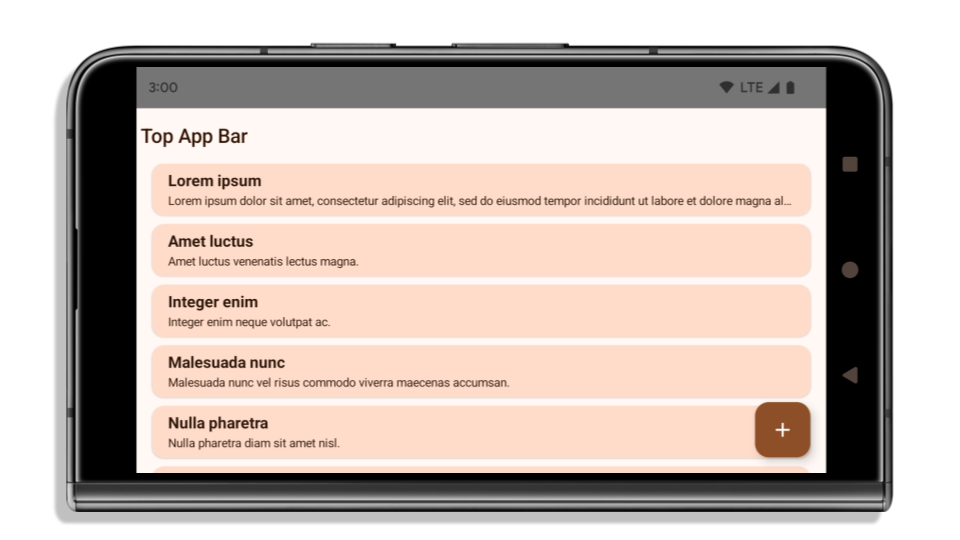
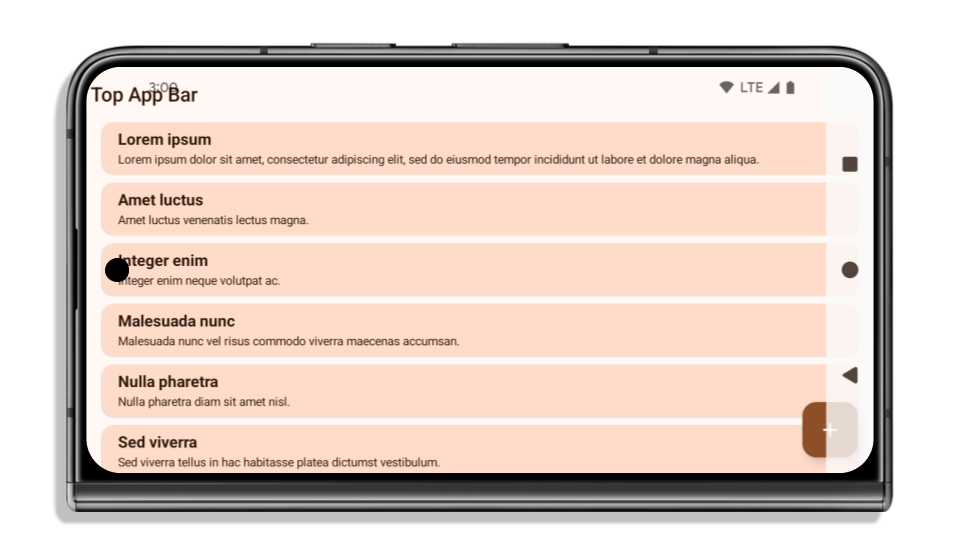
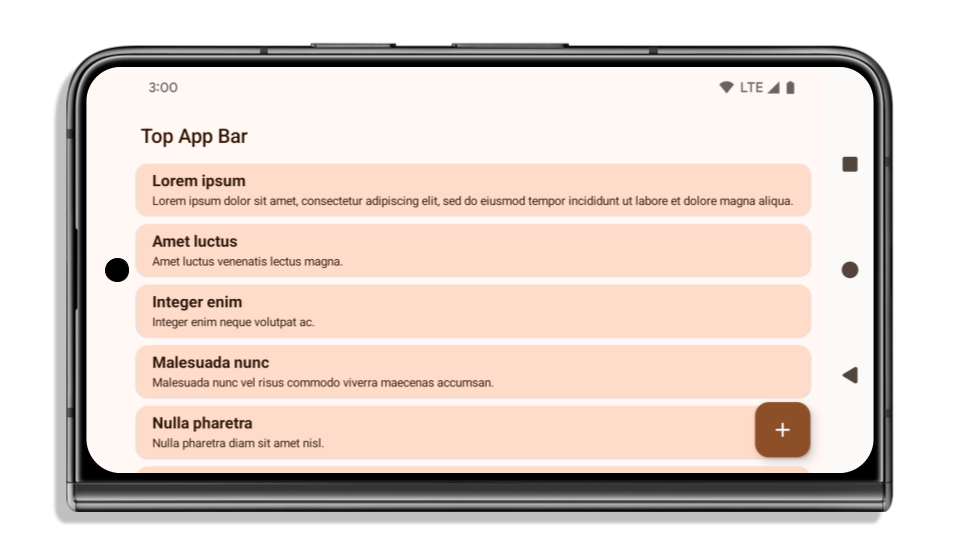
What to check if your app is already edge-to-edge
If your app is already edge-to-edge and applies insets, you are mostly unimpacted, except in the following scenarios. However, even if you think you aren't impacted, we recommend you test your app.
- You have a non-floating window, such as an
Activitythat usesSHORT_EDGES,NEVERorDEFAULTinstead ofLAYOUT_IN_DISPLAY_CUTOUT_MODE_ALWAYS. If your app crashes on launch, this might be due to your splashscreen. You can either upgrade the core splashscreen dependency to 1.2.0-alpha01 or later or setwindow.attributes.layoutInDisplayCutoutMode = WindowManager.LayoutInDisplayCutoutMode.always. - There might be lower-traffic screens with occluded UI. Verify these
less-visited screens don't have occluded UI. Lower-traffic screens include:
- Onboarding or sign-in screens
- Settings pages
What to check if your app is not already edge-to-edge
If your app is not already edge-to-edge, you are most likely impacted. In addition to the scenarios for apps that are already edge-to-edge, you should consider the following:
- If your app uses Material 3 Components (
androidx.compose.material3) in compose, such asTopAppBar,BottomAppBar, andNavigationBar, these components are likely not impacted because they automatically handle insets. - If your app is using Material 2 Components (
androidx.compose.material) in Compose, these components don't automatically handle insets. However, you can get access to the insets and apply them manually. In androidx.compose.material 1.6.0 and later, use thewindowInsetsparameter to apply the insets manually forBottomAppBar,TopAppBar,BottomNavigation, andNavigationRail. Likewise, use thecontentWindowInsetsparameter forScaffold. - If your app uses views and Material Components
(
com.google.android.material), most views-based Material Components such asBottomNavigationView,BottomAppBar,NavigationRailView, orNavigationView, handle insets and require no additional work. However, you need to addandroid:fitsSystemWindows="true"if usingAppBarLayout. - For custom composables, apply the insets manually as padding. If your
content is within a
Scaffold, you can consume insets using theScaffoldpadding values. Otherwise, apply padding using one of theWindowInsets. - If your app is using views and
BottomSheet,SideSheetor custom containers, apply padding usingViewCompat.setOnApplyWindowInsetsListener. ForRecyclerView, apply padding using this listener and also addclipToPadding="false".
What to check if your app must offer custom background protection
If your app must offer custom background protection to 3-button navigation or
the status bar, your app should place a composable or view behind the system bar
using WindowInsets.Type#tappableElement() to get the 3-button
navigation bar height or WindowInsets.Type#statusBars.
Additional edge-to-edge resources
See the Edge to Edge Views and Edge to Edge Compose guides for additional considerations on applying insets.
Deprecated APIs
The following APIs are deprecated but not disabled:
R.attr#enforceStatusBarContrastR.attr#navigationBarColor(for 3 button navigation, with 80% alpha)Window#isStatusBarContrastEnforcedWindow#setNavigationBarColor(for 3 button navigation, with 80% alpha)Window#setStatusBarContrastEnforced
The following APIs are deprecated and disabled:
R.attr#navigationBarColor(for gesture navigation)R.attr#navigationBarDividerColorR.attr#statusBarColorWindow#setDecorFitsSystemWindowsWindow#getNavigationBarColorWindow#getNavigationBarDividerColorWindow#getStatusBarColorWindow#setNavigationBarColor(for gesture navigation)Window#setNavigationBarDividerColorWindow#setStatusBarColor
הגדרה יציבה
אם האפליקציה מטרגטת ל-Android 15 (רמת API 35) ומעלה, Configuration כבר לא מוחרגות שורות המערכת. אם אתם משתמשים בגודל המסך במחלקה Configuration לחישוב הפריסה, כדאי להחליף אותו בחלופות טובות יותר כמו ViewGroup, WindowInsets או WindowMetricsCalculator, בהתאם לצורך.
Configuration זמין מאז API 1. בדרך כלל הוא מתקבל מ-Activity.onConfigurationChanged. הוא מספק מידע כמו צפיפות החלונות, הכיוון והגדלים. מאפיין חשוב לגבי גדלי החלונות שמוחזרים מ-Configuration הוא שבעבר לא נכללו בהם סרגלי המערכת.
גודל ההגדרה משמש בדרך כלל לבחירת משאבים, כמו /res/layout-h500dp, וזה עדיין תרחיש שימוש תקף. עם זאת, תמיד המלצנו שלא להשתמש בה לחישוב פריסת הדף. אם כן, עליך להתרחק ממנו עכשיו. צריך להחליף את השימוש ב-Configuration במשהו מתאים יותר בהתאם לתרחיש לדוגמה.
אם משתמשים בו לחישוב הפריסה, צריך להשתמש בViewGroup מתאים, כמו CoordinatorLayout או ConstraintLayout. אם משתמשים בו כדי לקבוע את הגובה של סרגל הניווט של המערכת, צריך להשתמש ב-WindowInsets. אם רוצים לדעת מה הגודל הנוכחי של חלון האפליקציה, משתמשים ב-computeCurrentWindowMetrics.
ברשימה הבאה מפורטים השדות שיושפעו מהשינוי הזה:
- המידות
Configuration.screenWidthDpו-screenHeightDpכבר לא כוללות את סרגלי המערכת. - השינויים ב-
screenWidthDpוב-screenHeightDpמשפיעים באופן עקיף עלConfiguration.smallestScreenWidthDp. - השינויים ב-
screenWidthDpוב-screenHeightDpמשפיעים באופן עקיף עלConfiguration.orientationבמכשירים שהיחס בין האורך לרוחב שלהם קרוב ל-1:1. Display.getSize(Point)מושפע באופן עקיף מהשינויים ב-Configuration. השימוש בשיטה הזו הוצא משימוש החל מרמת API 30.Display.getMetrics()כבר פועל כך מרמת API 33.
ערך ברירת המחדל של המאפיין elegantTextHeight הוא true
באפליקציות שמטרגטות את Android 15 (רמת API 35), המאפיין TextView של elegantTextHeight הופך ל-true כברירת מחדל, ומחליף את הגופן הקומפקטי שמשמש כברירת מחדל בסקריפטים מסוימים עם מדדים אנכיים גדולים, בגופן שקל יותר לקרוא אותו.
הגופן הקומפקטי הוצג כדי למנוע הפרעה לפריסות. בגרסה Android 13 (רמת API 33) מונעים הרבה מהפרעות כאלה על ידי מתן אפשרות לפריסת הטקסט להתמתח לגובה האנכי באמצעות המאפיין fallbackLineSpacing.
ב-Android 15, הגופן הקומפקטי עדיין נשאר במערכת, כך שהאפליקציה יכולה להגדיר את elegantTextHeight ל-false כדי לקבל את אותה התנהגות כמו קודם, אבל סביר להניח שהוא לא יקבל תמיכה בגרסאות הבאות. לכן, אם האפליקציה תומכת בסקריפטים הבאים: ערבית, לאוס, מיאנמר, טמילית, גוג'ראטית, קנאדה, מליאלאם, אודיה, טלוגו או תאית, צריך לבדוק את האפליקציה על ידי הגדרת elegantTextHeight לערך true.
 התנהגות של
התנהגות של elegantTextHeight באפליקציות שמיועדות ל-Android 14 (רמת API 34) וגרסאות ישנות יותר.
elegantTextHeight באפליקציות שמטרגטות את Android 15.שינויים ברוחב של TextView עבור צורות מורכבות של אותיות
In previous versions of Android, some cursive fonts or languages that have
complex shaping might draw the letters in the previous or next character's area.
In some cases, such letters were clipped at the beginning or ending position.
Starting in Android 15, a TextView allocates width for drawing enough space
for such letters and allows apps to request extra paddings to the left to
prevent clipping.
Because this change affects how a TextView decides the width, TextView
allocates more width by default if the app targets Android 15 (API level 35) or
higher. You can enable or disable this behavior by calling the
setUseBoundsForWidth API on TextView.
Because adding left padding might cause a misalignment for existing layouts, the
padding is not added by default even for apps that target Android 15 or higher.
However, you can add extra padding to preventing clipping by calling
setShiftDrawingOffsetForStartOverhang.
The following examples show how these changes can improve text layout for some fonts and languages.
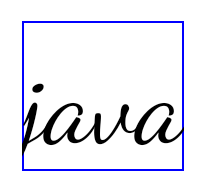
<TextView android:fontFamily="cursive" android:text="java" />
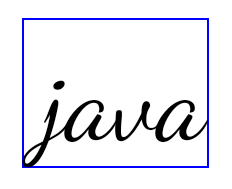
<TextView android:fontFamily="cursive" android:text="java" android:useBoundsForWidth="true" android:shiftDrawingOffsetForStartOverhang="true" />

<TextView android:text="คอมพิวเตอร์" />

<TextView android:text="คอมพิวเตอร์" android:useBoundsForWidth="true" android:shiftDrawingOffsetForStartOverhang="true" />
גובה שורה שמוגדר כברירת מחדל ב-EditText בהתאם ללוקאל
בגרסאות קודמות של Android, פריסת הטקסט הגדילה את גובה הטקסט כדי להתאים לגובה השורה של הגופן שתואם לאזור הנוכחי. לדוגמה, אם התוכן היה ביפנית, הגובה של הטקסט השתנה מעט כי גובה השורה של הגופן היפני גדול מעט מזה של גופן לטינית. עם זאת, למרות ההבדלים האלה בגובה השורות, הגודל של הרכיב EditText היה אחיד, ללא קשר לאזור הזמן שבו נעשה שימוש, כפי שמוצג בתמונה הבאה:

EditText שיכולים להכיל טקסט באנגלית (en), ביפנית (ja) ובבורמזית (my). הגובה של EditText זהה, למרות שלשפות האלה יש גובה שורות שונה זו מזו.באפליקציות שמטרגטות את Android 15 (רמת API 35), גובה שורה מינימלי מוקצה עכשיו ל-EditText כדי להתאים לגופן העזר של האזור הגיאוגרפי שצוין, כפי שמוצג בתמונה הבאה:

EditText שיכולים להכיל טקסט באנגלית (en), ביפנית (ja) ובבורמזית (my). הגובה של EditText כולל עכשיו מקום שמתאים לגובה השורה שמוגדר כברירת מחדל לגופנים של השפות האלה.אם צריך, אפשר לשחזר את ההתנהגות הקודמת של האפליקציה על ידי ציון הערך false למאפיין useLocalePreferredLineHeightForMinimum. אפשר גם להגדיר באפליקציה מדדים מינימליים מותאמים אישית של מודעות רגילות באמצעות ממשק ה-API setMinimumFontMetrics ב-Kotlin וב-Java.
מצלמה ומדיה
ב-Android 15 בוצעו השינויים הבאים בהתנהגות של מצלמה ומדיה באפליקציות שמטרגטות את Android 15 ואילך.
הגבלות על בקשת מיקוד אודיו
Apps that target Android 15 (API level 35) must be the top app or running a
foreground service in order to request audio focus. If an app
attempts to request focus when it does not meet one of these requirements, the
call returns AUDIOFOCUS_REQUEST_FAILED.
You can learn more about audio focus at Manage audio focus.
הגבלות מעודכנות שאינן ב-SDK
Android 15 כולל רשימות מעודכנות של ממשקי non-SDK מוגבלים, שמבוססות על שיתוף פעולה עם מפתחי Android ועל הבדיקות הפנימיות האחרונות. כשאפשר, אנחנו מוודאים שיש חלופות ציבוריות לפני שאנחנו מגבילים ממשקים שאינם ב-SDK.
אם האפליקציה שלכם לא מטרגטת ל-Android 15, יכול להיות שחלק מהשינויים האלה לא ישפיעו עליכם באופן מיידי. עם זאת, יכול להיות שהאפליקציה שלך תוכל לגשת לחלק מהממשקים שאינם SDK בהתאם לרמת ה-API לטירגוט של האפליקציה, אבל שימוש בשיטה או בשדה שאינם SDK תמיד כרוך בסיכון גבוה להפסקת פעולת האפליקציה.
אם אתם לא בטוחים אם האפליקציה שלכם משתמשת בממשקים שאינם SDK, אתם יכולים לבצע בדיקה לאפליקציה כדי לגלות זאת. אם האפליקציה שלכם מסתמכת על ממשקים שאינם SDK, כדאי להתחיל לתכנן מעבר לחלופות SDK. עם זאת, אנחנו מבינים שיש אפליקציות שבהן יש תרחישי שימוש לגיטימיים בממשקים שאינם SDK. אם אין לך אפשרות להשתמש בממשק שאינו SDK עבור תכונה באפליקציה, עליך לשלוח בקשה ליצירת API ציבורי חדש.
מידע נוסף על השינויים בגרסה הזו של Android זמין במאמר עדכונים לגבי הגבלות על ממשקים שאינם SDK ב-Android 15. מידע נוסף על ממשקים שאינם ב-SDK זמין במאמר הגבלות על ממשקים שאינם ב-SDK.

